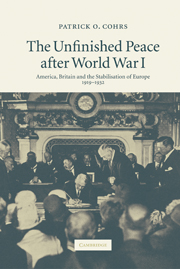Book contents
- Frontmatter
- Contents
- Acknowledgements
- List of abbreviations
- A note on the footnotes and bibliography
- Introduction
- Prologue
- 1 The wider challenges
- 2 Wilson, Lloyd George and the quest for a ‘peace to end all wars’
- 3 The ill-founded peace of 1919
- 4 The escalation of Europe's post-Versailles crisis, 1920–1923
- Part I The Anglo-American stabilisation of Europe, 1923–1924
- Part II Europe's nascent Pax Anglo-Americana, 1924–1925
- Part III The unfinished transatlantic peace order: the system of London and Locarno, 1926–1929
- Epilogue
- Conclusion
- Map: Post-World War I Europe after the peace settlement of Versailles
- Bibliography
- Index
3 - The ill-founded peace of 1919
Published online by Cambridge University Press: 21 July 2009
- Frontmatter
- Contents
- Acknowledgements
- List of abbreviations
- A note on the footnotes and bibliography
- Introduction
- Prologue
- 1 The wider challenges
- 2 Wilson, Lloyd George and the quest for a ‘peace to end all wars’
- 3 The ill-founded peace of 1919
- 4 The escalation of Europe's post-Versailles crisis, 1920–1923
- Part I The Anglo-American stabilisation of Europe, 1923–1924
- Part II Europe's nascent Pax Anglo-Americana, 1924–1925
- Part III The unfinished transatlantic peace order: the system of London and Locarno, 1926–1929
- Epilogue
- Conclusion
- Map: Post-World War I Europe after the peace settlement of Versailles
- Bibliography
- Index
Summary
What, then, were the central issues Lloyd George and Wilson had to tackle at Versailles? At the heart of the conference agenda lay the question what shape and place Germany was to have in the new international system. It was intricately bound up with the question of what price Germany would have to pay, both in terms of reparations and territory, for a war that in the eyes of the victors had been principally caused by its aggression. Around these questions, all wider challenges facing the peacemakers in Europe revolved – above all the paramount security question. What, if any, security architecture could bolster postwar stability? How far could Wilson's vision of a League-based world order harmonise with Lloyd George's bid for a new great-power directorate? How far, if at all, could both be reconciled with Clemenceau's aspirations? As will be seen, the French premier wanted to ban the German threat through a settlement based on force, a firm victors' alliance and an eastern neighbour stripped of much of its prewar territory, notably the Rhineland. Yet the German problem also underlay a second fundamental question – that of how to strike a balance between French security interests, the American championing of self-determination and the requirements of a stable international order. These particularly clashed in one area: eastern central Europe. Here, the interests of the defeated power stood against Polish, Czech and Slovak claims for nation-states of their own.
- Type
- Chapter
- Information
- The Unfinished Peace after World War IAmerica, Britain and the Stabilisation of Europe, 1919–1932, pp. 46 - 67Publisher: Cambridge University PressPrint publication year: 2006



